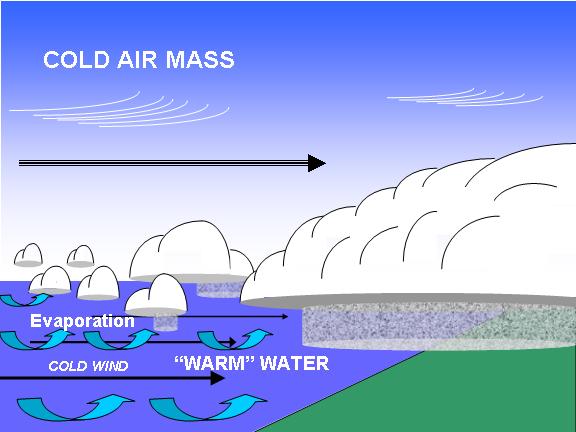Global Warming Is Probably Boosting Lake-Effect Snows?
In the aftermath of a massive lake-effect snowfall event in western New York state on Tuesday, it’s worth asking: Is climate change playing a role here? Because, I mean, come on. Seventy—seven zero—inches, people. And another huge round is forecast for Thursday, by the way. Buffalo deserves answers.
The short answer is: yes. Global warming is probably juicing
lake-effect snows, and we’ve had the data to prove it for quite some
time.
http://www.slate.com/blogs/future_tense/2014/11/19/lake_effect_snow_in_buffalo_climate_change_is_making_snowstorms_more_extreme.html


http://www.slate.com/blogs/future_tense/2014/11/19/lake_effect_snow_in_buffalo_climate_change_is_making_snowstorms_more_extreme.html

What causes lake effect snow? |
| Lake effect snow is caused when a very cold winter air mass
flows over the relatively warmer waters of a large lake. Intense evaporation from the
lake surface under these conditions forms
convective clouds that cannot contain all of this water, and some of it falls back to the
surface as snow.
Lake effect snow showers often organize themselves into bands or lines only a few miles across, with abrupt edges to the falling snow. The organization into lines is the result of wind shear (a change in wind speed or wind direction with height). If there is no wind shear, then the snow showers organize into individual snow shower clouds. The following satellite image shows lake effect snow bands flowing off of Lake Superior and Lake Michigan. |

What is convection? |
||
| "Convection" has several, related meanings in weather....but it always involves rising
air. It usually refers to "moist convection", where the excess water vapor in rising air
parcels condenses to form a cloud.
The heat released through this condensation can help to sustain the convection by warming the air further and making it rise still higher, which causes more water vapor to condense, so the process feeds on itself. But convection can also be dry, as occurs on a sunny day over the desert, or in more humid regions early in the day before the convection has become strong enough to form clouds. The sun warms the ground, and convective air currents help to remove the excess heat from the surface. Dry convection also occurs during the day even when clouds are not forming...you just can't see it. |
||
| Interesting facts: | ||
| MAKING THE EARTH LIVEABLE: Convection (both dry and moist) help to make the Earth liveable by removing excess heat from the surface, which is where most of the solar energy is abrobed by the Earth, and transporting it high into the atmosphere. It has been calculated that, without convection, the average surface air temperature on the earth would be about 125 deg. F, rather than the current 59 deg. F. | ||
| WHAT GOES UP, MUST COME DOWN: All of the air rising through convection must be balanced by an equal amount of sinking air elsewhere. This, clouds represent vertical circulation systems, involving rising air where the visible cloud forms, and sinking air around the cloud. |
Comments
Post a Comment